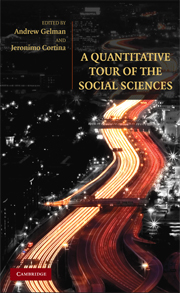Book contents
- Frontmatter
- Contents
- Preface: Learning to Think Like a Social Scientist
- About the Contributors
- PART I MODELS AND METHODS IN THE SOCIAL SCIENCES
- PART II HISTORY
- PART III ECONOMICS
- PART IV SOCIOLOGY
- 11 Models and Theories in Sociology
- 12 Explanations of the Racial Disturbances of the 1960s
- 13 The Time Series of Lynchings in the American South
- 14 Attainment Processes in a Large Organization
- PART V POLITICAL SCIENCE
- PART VI PSYCHOLOGY
- PART VII TO TREAT OR NOT TO TREAT: CAUSAL INFERENCE IN THE SOCIAL SCIENCES
- References
- Index
12 - Explanations of the Racial Disturbances of the 1960s
Published online by Cambridge University Press: 05 June 2012
- Frontmatter
- Contents
- Preface: Learning to Think Like a Social Scientist
- About the Contributors
- PART I MODELS AND METHODS IN THE SOCIAL SCIENCES
- PART II HISTORY
- PART III ECONOMICS
- PART IV SOCIOLOGY
- 11 Models and Theories in Sociology
- 12 Explanations of the Racial Disturbances of the 1960s
- 13 The Time Series of Lynchings in the American South
- 14 Attainment Processes in a Large Organization
- PART V POLITICAL SCIENCE
- PART VI PSYCHOLOGY
- PART VII TO TREAT OR NOT TO TREAT: CAUSAL INFERENCE IN THE SOCIAL SCIENCES
- References
- Index
Summary
I'd like to turn to some specific studies that illustrate the kinds of explanations I outlined in Chapter 11. I'll start with an example of the demographic type of explanation as developed in a paper of mine from 1970, “The Causes of Racial Disturbances: A Comparison of Alternative Explanations.” The 1960s was a period of great social turmoil in the United States. This decade witnessed the assassinations of John F. Kennedy and Martin Luther King, the riots precipitated by the Vietnam War, and a great many racial disorders. Some years ago, I undertook a study of the reasons for the racial outbreaks. As a first step, I sought to ascertain the broad assumptions that had to be part of an adequate explanation of the racial disturbances. Thus, in the first section of the article, various models, reflecting different kinds of assumptions, were examined in an attempt to understand the general features of the process that “generated” the disorders. In the second section, I attempted to account for the disorders by estimating the parameters of the model structure deduced in the first section. It's the initial section of the article that I want to discuss now.
What do we mean when we say that we want to “explain” the racial disturbances? There are actually a number of subquestions involved. First, there is the matter of why the outbreaks occurred where they did. Second, there is the issue of explaining when they took place; why, in particular, during the 1960s?
- Type
- Chapter
- Information
- A Quantitative Tour of the Social Sciences , pp. 164 - 175Publisher: Cambridge University PressPrint publication year: 2009



